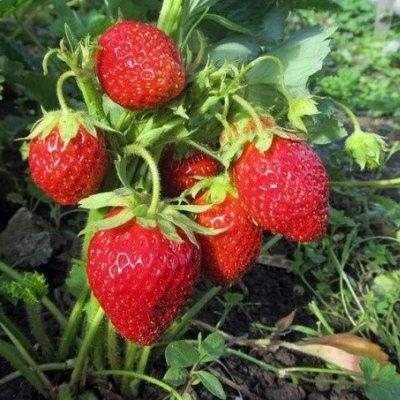
- Taste: cherry-tinted
- The size: average
- Yield: 0.4-0.5 kg per bush
- Ripening terms: medium
- Appointment: universal
- Description of the bush: undersized
- Berry color: Dark red
- Winter hardiness: medium
- Height and width of the bush: height 20 cm
- Pulp: red
Cherry Berry is an unusual strawberry with a deep, rich skin color. The plant gives fruits for universal purposes, well suited for conservation and fresh consumption. Cherry Berry needs space in the beds, but the harvest redeems all the shortcomings.
Description of the variety
The cherry berry strawberry belongs to the undersized subspecies. Bushes grow compact, about 20 cm high. Peduncles are very long, they are formed quite actively. The petals are white, the middle of the buds are yellow. Leaves are light green, to match the shoots.
Ripening terms
The average ripening period allows growing the Cherry Berry variety in regions with different climates.
Yield
You can get 0.4–0.5 kg of berries from a bush. The variety is not remontant, it blooms and bears fruit once.
Berries and their taste
Cherry Berry has an unusual berry taste with a pronounced cherry flavor. The pulp is red, firm and juicy. The size of the berry is medium, the shape is neat, drop-shaped, slightly rounded. The sides are glossy.
Growing features
The variety is considered unpretentious, easy in agricultural technology. Cherry Berry responds well to abundant moisture and fertilization of the soil. When planting, a distance of 70 cm is maintained between the bushes. The depth of the planting pit is limited to 300 mm. It is recommended to transfer the plants to the ground in late autumn or spring.
For a non-renovated variety, crop rotation is of great importance. In one place, Cherry Berry is grown for no more than 5 years, and then transplanted. It will be possible to return it to its old place no earlier than in 4 years.




Site selection and soil preparation
For planting, a bed is chosen that is well illuminated by the sun most of the time. Suitable soil - light to medium texture. The optimum acidity is 5.0–6.5 pH. The bed should warm up well, but not dry out. It must be protected from drafts.
For spring planting, soil preparation is carried out in advance.The soil is carefully dug up, adding to it at least 1 bucket of organic matter per 1 m 2. Also, a double superphosphate in an amount of about 40 g and wood ash are laid on the garden bed. In the fall, mineral complexes and organic matter are applied together about 2 weeks before planting.

Pollination
Plants successfully cope with it themselves. It is not necessary to cross-pollinate them.
Top dressing
Strawberry Cherry Berry responds equally poorly to lack and excessive fertilization. They begin to be introduced in the spring, when the first leaves appear. The easiest way is to take ready-made granular complexes, burying them in the soil during the loosening process. You can give the plants additional feeding with liquid organic matter, diluted sufficiently so as not to burn the roots. Mineral fertilizers that Cherry Berry receives in summer are also given in autumn, but having reduced the dosage by 2 times.

One of the important techniques in strawberry care is feeding. Regular fertilization guarantees a rich harvest. There are several different ways to feed strawberries, and each of them is designed for a specific period of plant development. During flowering, fruiting and after it, feeding should be different.
Frost resistance and the need for shelter
Cherry Berry has average winter hardiness. Leaving the bushes outdoors in winter is only possible in very warm regions. In other cases, the plants must be covered to avoid freezing of the roots.

Diseases and pests
The variety is considered resistant to major diseases. Despite this, he requires mandatory preventive treatment against diseases and pests in early spring. During this period, fungicides with copper content or self-prepared Bordeaux mixture are used. This will protect plants from damage by spotting, powdery mildew or verticillosis.

Strawberries are often subject to many dangerous diseases that can seriously undermine its condition. Among the most common are powdery mildew, gray mold, brown spot, anthracnose, and verticillosis. Before buying a variety, you need to inquire about its disease resistance.
Reproduction
The variety does not form a mustache. It is only possible to grow from seeds or propagate by dividing the bush. It is quite difficult to get seedlings on your own. If there are adult plants, they are carefully cut longitudinally, keeping each part with its own root and leaf rosette.

Review overview
According to most gardeners, Cherry Berry can be attributed to those varieties that become a real decoration of the garden. The unusual combination of skin tone and pulp taste is liked not only by gourmets, but also by people who want to try something new. The variety is often compared to the Pineberry, with which it is related to the shape of the berry and some other characteristics.Cherry Berry is often planted exclusively for fresh consumption.
The disadvantages include the tendency of the variety to freeze in cold climates. In addition, long stalks droop as the berry ripens. The soil under them must be mulched. Buyers note the low germination rate when grown from seeds.


















































































